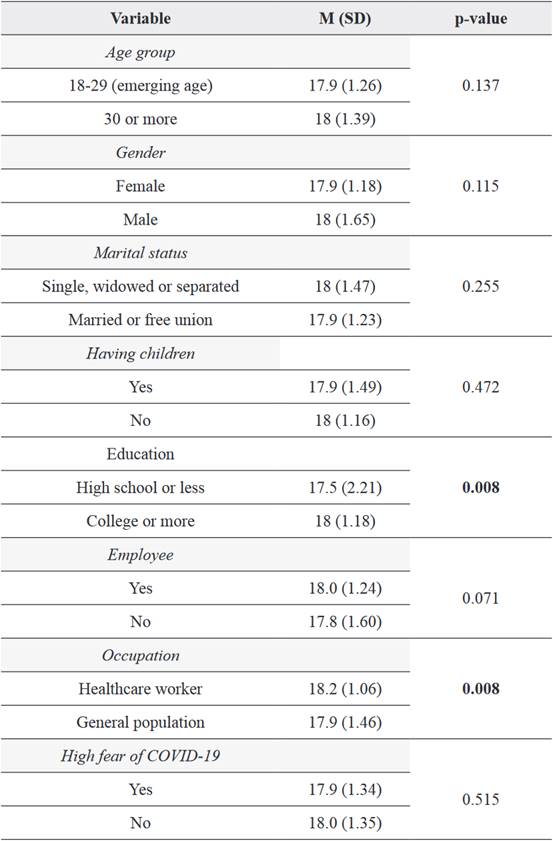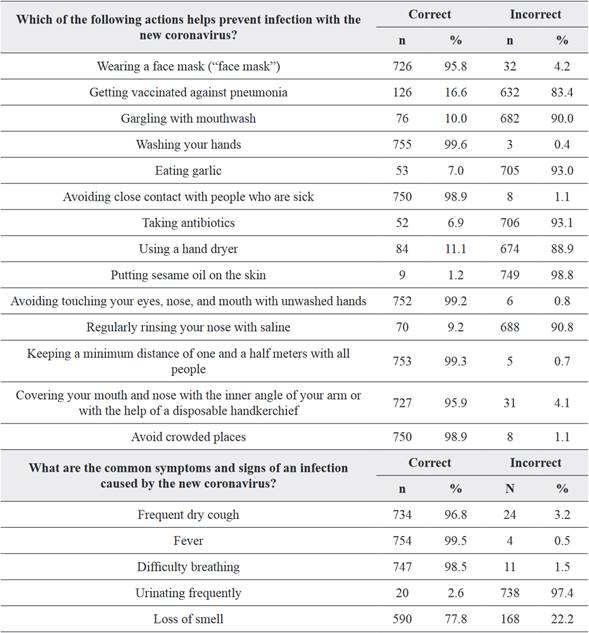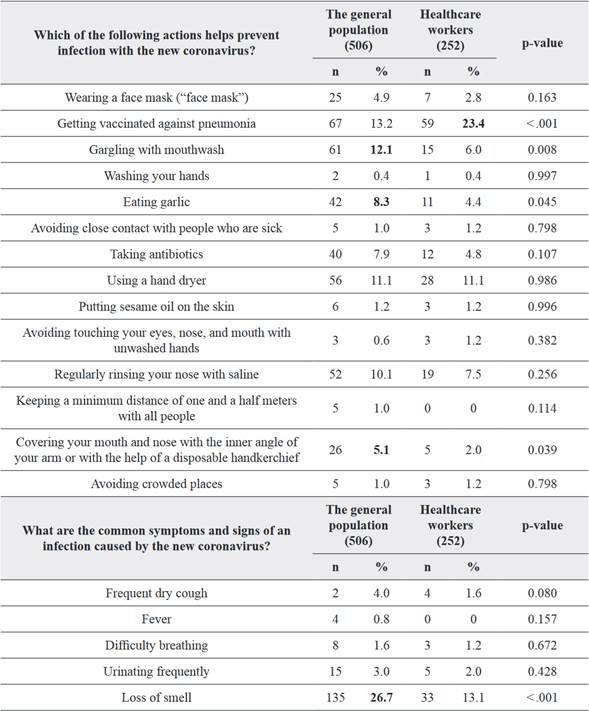Introduction
Since the emergence of COVID-19 in December 2019 in the city of Wuhan, China 1, the epidemiological behavior of the disease has been characterized by rapid global spread 2, primarily due to its highly transmissible nature 3, eventually leading to its declaration as a pandemic in March 2020 4.
Despite the implementation of various strategies worldwide to curb the spread of the virus, such as restrictions of group gatherings, cancellation of public events, border closure, limitations in mass transportation, emphasis on hand hygiene, mask usage, avoiding touching the face, practicing social distancing, and isolating infected individuals 5,6,7, these measures may prove insufficient if not accompanied by educational interventions. Additionally, preventive measures can be hindered by a lack of knowledge among the population 8, especially in low-income countries 9, which is the case in many parts of Latin America 5,7,10.
Moreover, it is worth noting the experience during the Severe Acute Respiratory Syndrome (SARS) epidemic from 2002 to 2004, where misconceptions and excessive fear among the general public led to non-compliance with protective measures mandated by governing bodies, consequently facilitating rapid transmission 11,12. In the current COVID-19 pandemic, it has been demonstrated that a low level of knowledge about the disease contributes to its rapid spread 6,13, as people fail to adhere to control measures 14 and cultural norms, such as frequent visits among family and friends and the significance of physical contact 6.
Convincing the population to adopt personal hygiene practices and adhere to social distancing measures remains a challenge in containing SARS-CoV-2 infection 8. Therefore, it is crucial to assess the general public’s knowledge of COVID-19, not only to gauge their willingness to comply with behavior change measures established by health authorities 15, but also to promote informed decision-making based on available evidence 8. Rapid online surveys have proven to be a valuable method for evaluating the knowledge of the general public during infectious disease outbreaks 13. However, to our knowledge, no studies have assessed such knowledge among the Mexican population.
This research aimed to describe the level of knowledge about COVID-19 among the general population of Mexico and explore the factors associated with high knowledge regarding the disease.
Method
Participants
A non-probabilistic sample of voluntary participants was utilized. Due to distance restrictions, adult male and female residents were invited to participate through various social networks such as email, WhatsApp, Facebook, etc. The minimum sample size was estimated at 384 individuals using the proportions estimation model. The sample size was used considering a proportion of 50%, with a confidence level of 95% 16, with an error margin of 5% or as low as 10%, with an error margin of 1%. Ultimately, the sample consisted of 758 individuals. The inclusion criteria were being 18 years of age or older and to having the ability to complete online questionnaires.
Measurements
The research questionnaire comprised demographic variables such as age, sex, marital status, education level, occupation, socioeconomic status (income level), a COVID-19 knowledge questionnaire, and a COVID-19 fear scale.
Knowledge about COVID-19
The COVID-19 Knowledge Questionnaire was based on a 22-item survey developed by Geldsetzer et al. 17, which included true or false questions to assess knowledge about the epidemic, addressing common myths as highlighted by the World Health Organization 18. Standard translation and back-translation procedures were carried out to ensure linguistic equivalence 19, with particular attention given to avoiding confusion negative phrasing in Spanish 20. A panel of experts reviewed the questionnaire and selected 19 for inclusion in the study 21. Fourteen questions focused on actions or strategies to prevent infection, while five questions addressed common symptoms of the disease. Each correct response was awarded one point, resulting in a total possible score ranging from 0 and 19. The scores were dichotomized using the third quartile (19 points) as the cutoff for high knowledge of COVID-19.
COVID-9 fear scale
The five-item COVID-19 Fear Scale FCV-5 22, derived from a refinement process of a previously developed seven-item original scale 23, was employed. The FCV-5 provides four response options (always, almost always, seldom, and never) with corresponding scores ranging from zero to three, yielding a total score between 0 and 15. Scores equal to or greater than four were categorized as indicating a high fear of COVID-19. Previous studies in Colombia have demonstrated acceptable validity and reliability indicators for this instrument 24. In this study, the FCV-5 exhibited satisfactory reliability measures, with a Cronbach’s alpha = 0.75 and McDonald’s omega = 0.78.
Process
An online questionnaire was distributed via emails and social networks such as Facebook, Instagram, and WhatsApp. The introductory section provided information about the study objectives and ethical considerations. Participants interested in taking part were required to confirm their legal age and provide informed consent. Completing the research questionnaire took approximately five to ten minutes, and all questions were mandatory to avoid missing data. The questionnaire was available for completion from July 3rd and August 10th, 2020.
Analysis of data
The descriptive analysis involved calculating frequencies and percentages for nominal and ordinal variables. For quantitative variables, the mean (M) and standard deviation (SD) were calculated. When necessary, the Shapiro-France test was used to assess the distribution of the data 25. For skewed data, the median (Me) and interquartile range (IQR) were determined.
In the bivariate analysis, the association between sociodemographic variables and knowledge about COVID-19 was examined. Prevalence ratios (PR) and 95% confidence intervals (95% CI) were calculated. The knowledge scores between independent samples were compared using the Mann Whitney U. The proportions of incorrect responses on each questionnaire were compared using the chi-square test, differentiating between the general population and healthcare professionals. Statistical significance was set at p<0.05. The data were processed and analyzed using SPSS® program, version 24 (IBM Corp. Released 2012. IBM SPSS Statistics for Windows, Version 24.0. Armonk, NY: IBM Corp.).
Ethical considerations
The research project was approved by the research ethics committee at Colombia State University (Minutes 004 of May 13th, 2020). The research adhered to the ethical recommendations for research involving human subjects as outlined in the Declaration of Helsinki. Participants provided informed consent, and measures were taken to ensure anonymity, respect for privacy, and confidential handling of all information collected in the research questionnaire was guaranteed.
Results
Social and demographic characteristics
A total off 758 participants, with an age range of 18 to 74 years (M=37.3 SD=12.6), took part in the study. Among them, 33.4% (n=253) were under 30 years old, 68.5% (n=519) were female, 53.0% (n=402) were married or cohabiting, 53.4% (n=405) had children. Regarding education, 88.9% (n=674) had higher education, 74.3% (n=563) were employed. Only 33.2% (n=252) were healthcare workers, and 36.6% (n=275) reported a high fear of COVID-19.
Knowledge about COVID-19
The participants achieved correct answers ranging from 2 to 19 points on the COVID-19 knowledge Questionnaire (M=18, SD=1.35, Me=18, IQR=17-19). A total of 41.0% (n=331) of the participants answered the entire questionnaire correctly. Table 1 shows the percentage distribution of each of the questions.
Participants with higher education and health professionals were found to have better knowledge scores on COVID-19. The other variables did not show differences in knowledge scores. See Table 2.
Table 2 Comparison of knowledge scores according to demographic variables.

Source: Compiled by authors.
An association was observed between occupation, specifically being a health professional and having high knowledge about COVID-19. See the findings in Table 3.
Table 3 Association between demographic variables and adequate knowledge about COVID-19.
| Variable | PR (95%CI) |
|---|---|
| Emerging age (18-29 years) | 0.84 (0.69-1.02) |
| Female gender | 0.87 (0.73-1.03) |
| Single widowed or separated | 1.12 (0.95-1.33) |
| Having children | 1.09 (0.92-1.3) |
| High school or less | 0.76 (0.55-1.05) |
| Having a job | 1.17 (0.95-1.44) |
| Healthcare worker | 1.25 (1.05-1.48) |
| High fear of COVID-19 | 1.09 (0.91-1.30) |
Source: Compiled by authors.
According to Table 4, when comparing the general population to healthcare workers as the reference group, it was found that a higher percentage of individuals from the general population answered incorrectly to the questions about gargling, eating garlic, covering the nose and mouth, and loss of smell compared to healthcare workers. On the other hand, healthcare workers had a higher percentage of errors when asked about getting vaccinated against pneumonia as a measure to prevent infection.
Discussion
The results of this study indicate a low percentage of people with high knowledge about COVID-19, which is consistent with findings from other studies 8,9,26 that found percentages of knowledge of 33%, 61.6%, and 63%, respectively, but lower than the knowledge reported in other studies that exhibit percentages of adequate knowledge in the general population higher than 70% 6,14,15,27. These differences in knowledge levels could be attributed to various factors such as the use of different instruments 8, the novelty and uncertainty surrounding the disease 15, and the prevalence of misinformation in the media 28,29.
This study emphasizes that the population’s knowledge about the disease plays a crucial role in prevention 15, even more when on average, a sick person could infect between 2.2 and 3.9 more subjects during the natural course of the disease 30. Rapid assessments of knowledge and perceptions among the population are crucial in public health efforts 13. Education plays a significant role in improving knowledge about the disease 6,14, especially in Latin America, where indicators of education access and quality are affected by poverty and social inequities 31, especially in times of pandemic 32. The present study found that individuals with higher education tend to have higher knowledge compared to those with primary and secondary education. Similar patterns have been observed in other regions like Asia and the Middle East 8,14,26, Africa 6,9,27 and South America 5.
Healthcare workers play a key role in the prevention and treatment of diseases such as COVID-19 33. Their knowledge about COVID-19 is associated with better service attitudes 34. This study found that health professionals have higher knowledge about COVID-19 (47.2%) compared to the general population (37.9%) (PR=1.25, 95%CI 1.05-1.48). Other studies have found knowledge percentages about the disease above 70% in health service providers. However, these percentages were not compared to the general population 35. We found only one study that compared knowledge between healthcare professionals and the general population. Although this study indicated that both groups were well-informed about SARS-CoV-2, it did not disclose the percentages of knowledge in both populations or details about how this knowledge was measured, and whether it was adequate or not 36.
Regarding knowledge about COVID-19, both health professionals and the general population in Mexico showed percentages higher than 95% of correct answers for symptoms such as cough, fever and difficulty breathing. These data coincide with a comparative study between the United States and the United Kingdom 13 and with the percentages exhibited in a study in India 36, which also compared the general population with healthcare workers.
The finding that the general population has a higher percentage of individuals identifying loss of smell is a common symptom of COVVID-19 compared to is healthcare workers can be explained by several factors. Initially, a striking finding is the evidence from systematic reviews and meta-analyzes that anosmia is a common symptom in more than 40% of patients diagnosed with COVID-19 37,38,39. This symptom may have been considered present by healthcare personnel but not as frequently encountered as a strong diagnostic predictor symptom 40. It seemed premature to conclude without a doubt that anosmia was useful to diagnose COVID-19 41. On the other hand, healthcare workers, due to their professional training and clinical experience, possess a greater ability to discriminate between symptoms and understand their weight for diagnosis or their frequency within the overall clinical presentation of COVID-19 35. In contrast, the general population’s knowledge on the subject is more limited, allowing them to recognize that loss of smell may be a symptom, but not necessarily discerning its frequency or significance compared to other symptoms 42.
This study discovered that in the general population, there is a common belief that gargling with mouthwashes and consuming garlic are effective measures to prevent infections. The findings align with a binational study conducted in Egypt and Nigeria, where only 18.4% of the respondents accurately answered a question regarding the use of garlic as a preventive measure 9. Other studies involving general populations in the United States and the United Kingdom have indicated that 43.5% and 36% of individuals, respectively, believe that gargling with mouthwash is an effective preventive measure 13,17. Similarly, the present study revealed a higher percentage of incorrect responses (5.1%) from the general population regarding the effectiveness of covering the nose and mouth to prevent infection, compared to the same question. Among healthcare professionals, the percentage of incorrect responses was 2.0%. These results are consistent with a study conducted in India among healthcare personnel, where 4% answered incorrectly to the same question 36. These findings emphasize the need to continue improving education on prevention measures not only among the general population but also among healthcare professionals 43.
It is noteworthy that the percentage of healthcare workers who answered the question about vaccines as a preventive measure for infection incorrectly (23.4%) was nearly double that of the general population (13.2%). This finding is consistent with the study conducted by Parikh et al. 36, which revealed that healthcare workers had less knowledge about the role of regular influenza vaccination in preventing COVID-19 compared to the general population (23,5% versus 15.1%). This observation can be attributed to the lack of direct evidence that pneumonia vaccination prevents COVID-19 40. However, there is some indirect evidence suggesting that the pneumococcal vaccine can help mitigate the impact of COVID-19 on health systems by reducing morbidity and mortality from respiratory infections, among individuals with significant risk factors such as advanced age and multimorbidity 44. It may seem paradoxical that healthcare workers, who have better access to this type of information, could harbor the false notion that the pneumonia vaccine acts as a protective factor against COVID-19, leading to an erroneous response on this matter 45.
Knowledge about COVID-19 is a crucial, particularly in terms of prevention 36, and health workers play a critical role in this regard 33. Therefore, it is vital to enhance their understanding of the subject. Professionals with a better grasp of the disease are expected to practice more effective preventive measures and contribute its containment 44.
To mitigate the impact of the pandemic, governments worldwide have implemented stringent preventive measures, including mandatory quarantines, border closures, restrictions on public gatherings, robust epidemiological surveillance, and campaigns promoting handwashing and physical distancing. However, the effectiveness of such measures has been hampered by the limited among the general population’s disease 8. Therefore, altering individual behaviors possess a significant challenge for nations. To design effective interventions, it is imperative to know the population’s knowledge of the disease5.Studies focusing on the knowledge of COVID-19 among the general population provide decision-makers with valuable insights to develop reliable awareness campaigns 8. This is a crucial to ensure effective participation and acceptance of the recommended measures proposed by the health authorities 15.
As for the limitations of the study, it is important to note that its cross-sectional nature, which precludes establishing causal relationships between the identified associations. Furthermore, the absence of a probabilistic sample restricts the ability to make inferences about the general population. It is therefore recommended to design studies that meet both of these conditions. Finally, it is important to consider the timeframe in which the data was collected (between July and August 2020). This temporal aspect may have influenced the expected response patterns compared to the current level of knowledge. Additionally, it is worth noting that more than one-third of the participants in the online survey were employed an had higher education level and moderate income levels.
Conclusions
In conclusion, individuals with higher education and health professionals demonstrated higher knowledge scores regarding COVID-19. However, it is important to note that their higher knowledge about COVID-19 was only significantly associated with being a health professional. It is crucial to interpret these results with consideration for the timeframe in which the information was collected.
















